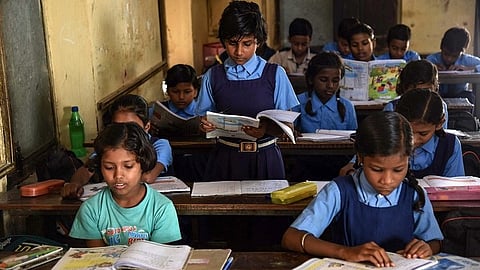

Every Children’s Day, we celebrate the potential of young minds. But if we truly want to secure their future, we must ask what kind of world we are preparing our children for. For India’s 25 crore school-going children, the climate crisis is not a distant headline; it’s their lived reality.
Across the country, classrooms are flooded, heatwaves disrupt exams, and polluted air is the new normal. Climate change will impact lives and jobs as much as, if not more than, Artificial Intelligence (AI), which is already getting its own curriculum.
Yet, most schools have barely scratched the surface of why the climate crisis is happening and what they can do about it.
The climate crisis and its impacts are often reduced to a few textbook paragraphs or an annual ‘environment day’ event. But climate literacy and understanding how our policies and choices affect ecosystems, weather, water, and health can no longer be optional. Being able to see the interconnections between these is now a life skill.
A handful of states have already started recognising this. Tamil Nadu is gearing up to launch 21 climate literacy sessions for students in government and aided schools. This is a pioneering initiative under its Climate Change Mission.
Kerala has integrated sustainability concepts into schools through its Haritha Vidyalayam programme, and Karnataka has started climate action clubs in Bengaluru and is roping in schools and students to create climate action plans for their institutions.
But most states are lagging. Climate education remains insufficiently framed and is fragmented. Coupled with a lack of dedicated funds, passionate educators and civil society organisations do not see a way forward to build programmes and curricula that integrate climate literacy.
What’s missing is systemic funding. India spends around 3-4% of its GDP on education, despite the 6% benchmark set by the National Education Policy. Within this, allocations for environmental or climate education are negligible, often subsumed under generic ‘awareness’ programmes.
Without ring-fenced budgets, even well-intentioned projects struggle to scale or sustain themselves.
Dedicated funding could change this. It could support the creation of climate education cells within state education departments, teacher-training programmes focused on pedagogy for climate understanding and action, adaptation and translation of existing curricular resources into local languages, and the development of region-specific curriculum that connects climate science and justice to everyday realities.
Funding climate education is a climate adaptation move. As a Bengaluru school student eloquently said in the recently held Makkala Sabhe (a debate event for the city’s school climate action clubs) - “climate education is the manual for the next generation’s survival”.
A climate-literate generation can anticipate risks, innovate locally, and demand accountability from policymakers. The return on this investment is enormous: a society that is resilient to the climate crisis and respectful of the environment.
The Indian and International philanthropic community and CSR ecosystem, which has invested heavily in education, skills, and health, is yet to recognise climate resilience for children as a strategic priority, even as it sits precisely at the intersection of all three.
To elucidate this, let's take a foundation focused on empowering young girls. They want to focus their investment in educating, ensuring access to nutrition and skilling them. But they fail to realise that the return on such an investment is often dictated by the resilience and adaptation measures taken by the school, families and local administration in the face of a disaster.
Studies show that in the aftermath of a flood, drought or heatwave, 80% of the displaced are female. Girls are more likely to be pulled out of schools and burdened with domestic work, forced into child marriage, deprived of nutritious food (when resources are scarce) or suffer violence and exploitation, to enable their families to cope.
Climate education can help solve this problem. A well-designed climate curriculum can teach young people not only about emissions and their role in ecosystem collapse but also about the social dimensions of resilience. This would mean providing empowering perspectives in the curriculum around energy access, sustainable agriculture, and inclusive growth.
The ‘curriculum’ must be seen for what it is-- a powerful tool to ensure societies flourish.
The economic case for climate education is clear. The International Labour Organisation estimates that India could create up to three million new green jobs in the renewable energy sector alone by 2030. But without a climate-literate workforce, these opportunities will bypass young Indians. So, it is safe to say that funding climate education is not really charity- it is a smart investment.
On the flip side, the costs of inaction are staggering. Each flood, drought, or heatwave costs us thousands of crores in loss and damage. Building a generation that understands prevention, adaptation, and sustainable resource use will reduce post-disaster spending in the long term.
This Children’s Day, let’s move beyond just celebrations and make a tangible promise: that every child in India will learn how to live, think, and work in a changing climate. The next generation doesn’t need pity or platitudes- they need preparation.
Pallavi Phatak is the Director, Climate & Education Programme, Asar Social Impact Advisors.
Priyanka Thirumurthy is the Head of Communications - Climate & Education, Asar Social Impact Advisors
Views expressed are the authors’ own.